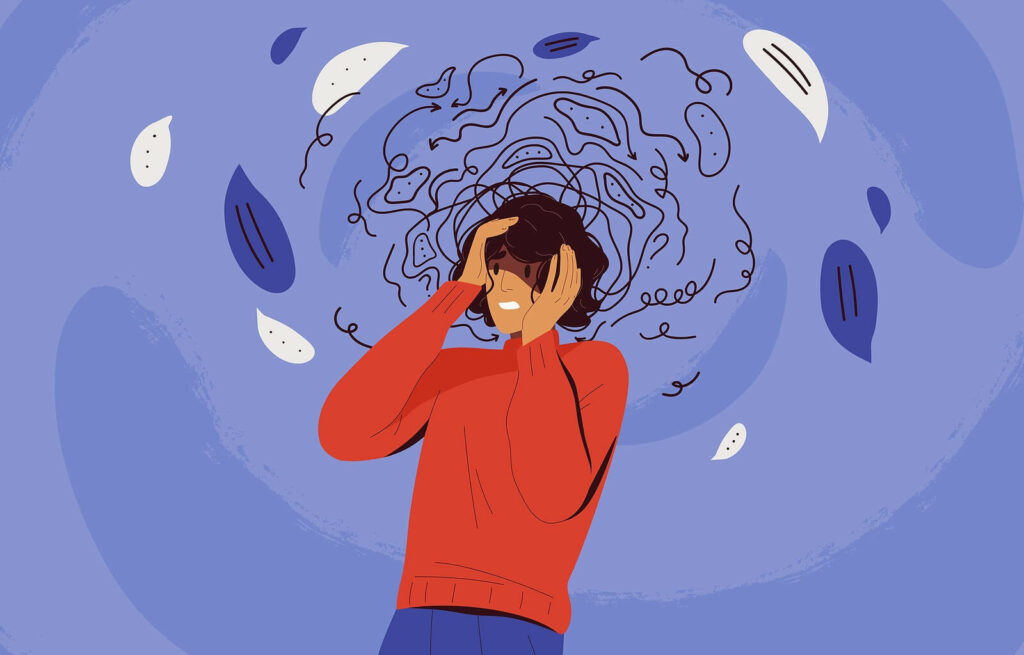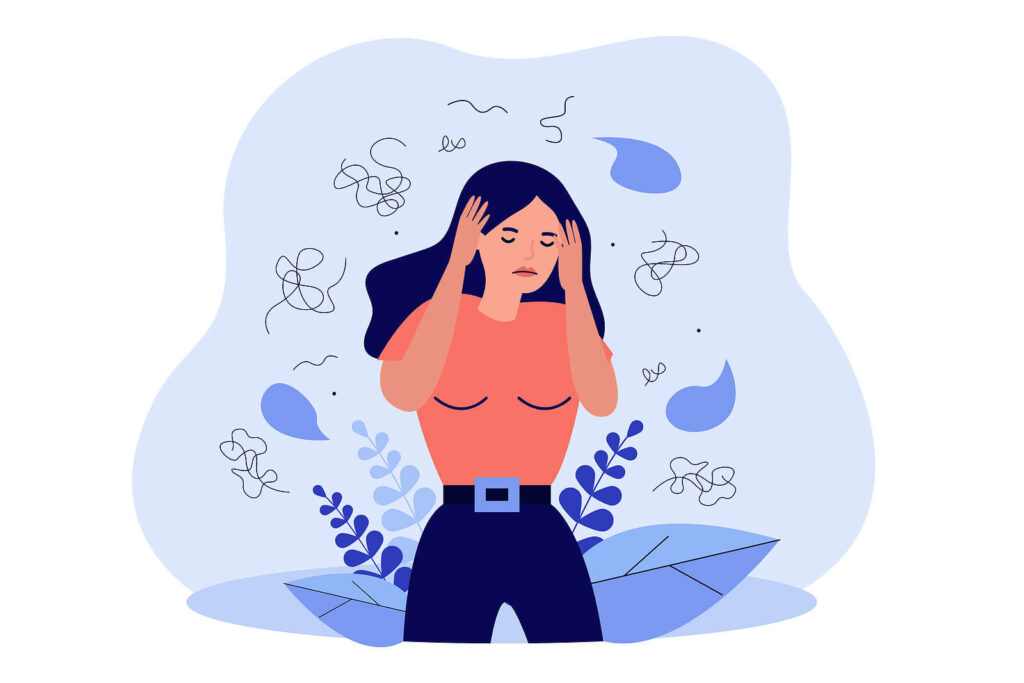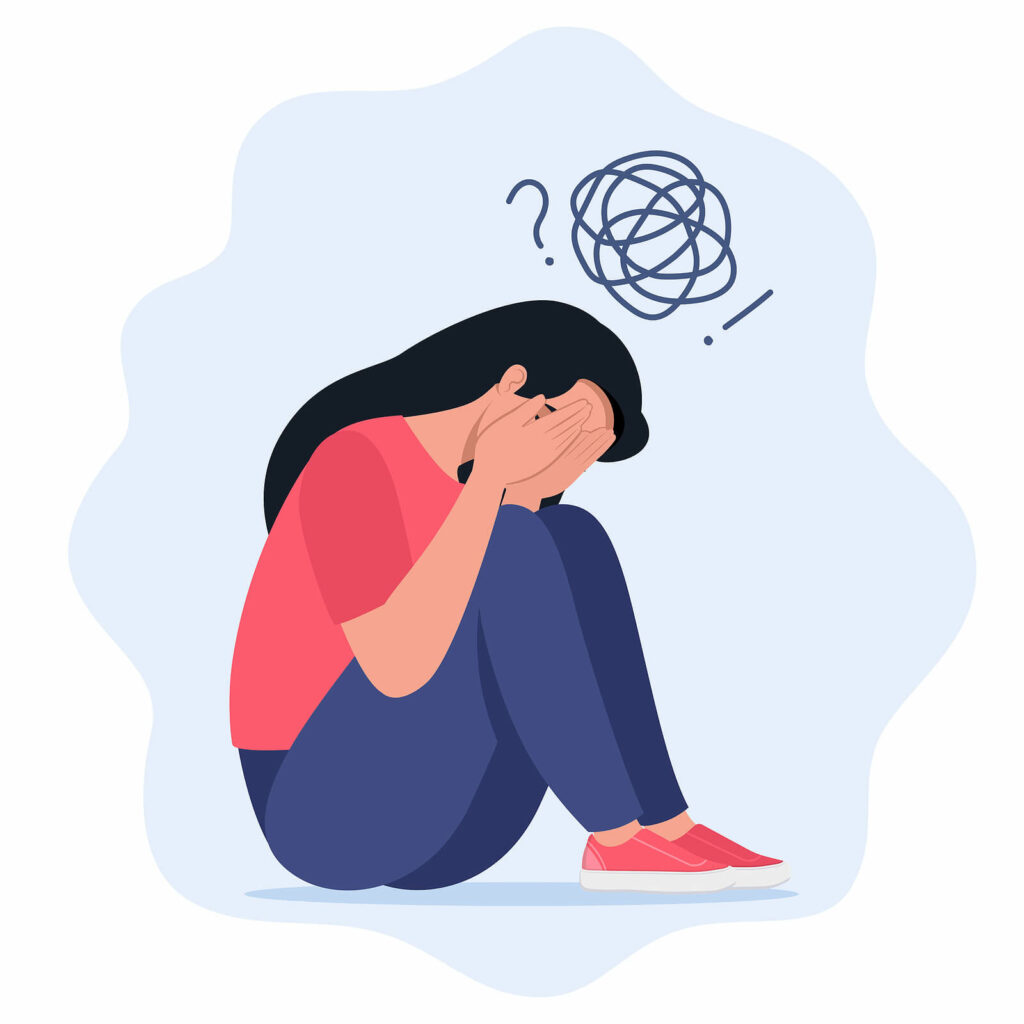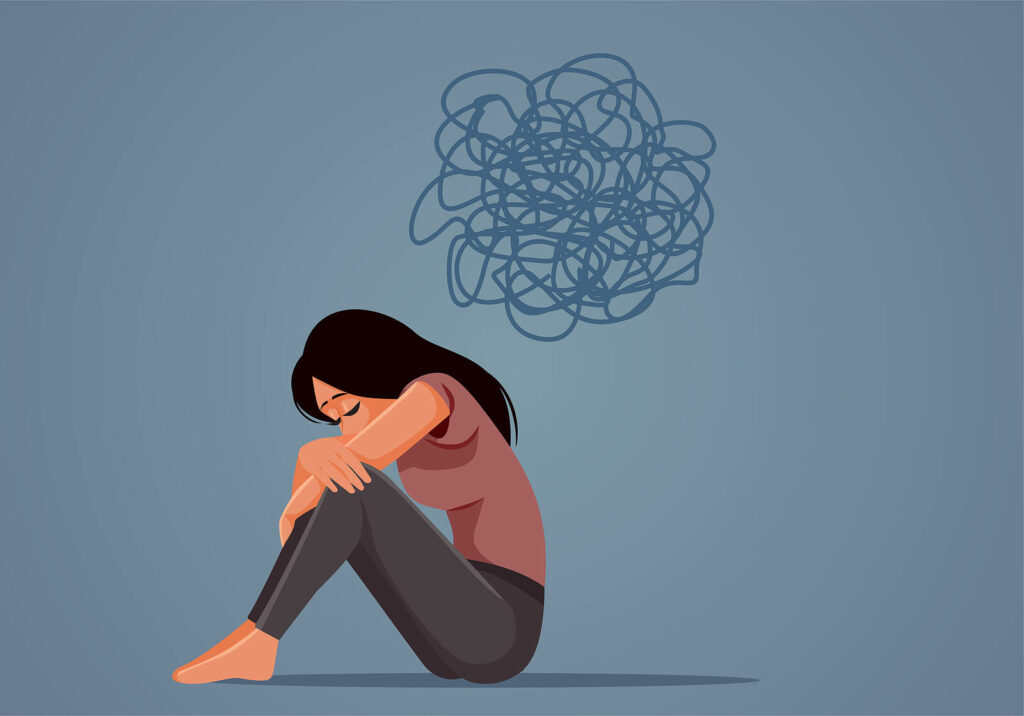Why can’t I just turn off my brain?

Ruminating Thoughts are Stressful
Intrusive, obsessive, and ruminating thoughts are a part of living with ADHD. No matter how hard you try to ignore them, those negative thoughts just keep coming back, replaying in your head over and over. You know it’s not healthy, and you wish you could think about anything else, but you can’t seem to stop yourself from having ruminating thoughts.
When you have ADHD your mind is always on, which feels like thinking ten thoughts at once. It can be hard to express all those thoughts at once, and difficult to prioritize which thought should be prioritized for sharing. The tendency for impulsivity makes it difficult for Those with ADHD can often get burned by their impulsivity, so they can sometimes go to the opposite extreme and micro-analyze, especially in social situations. But what you resist, persists. Meaning, the more you try to ignore these thoughts, the more persistent they become. Like many things related to ADHD, being told to ‘just forget about it and relax’ or ‘just let it go’ are not helpful. At ATTN Center our caring team of therapists specializes in these ADHD-related issues and understands it takes specialized care to overcome them.
What are Ruminating Thoughts?
ADHD brains aren’t the only ones prone to rumination. All brains ruminate and are essentially programmed to do it. Think back to when our only human goal was survival, which wasn’t that long ago when we had to worry about things like protecting ourselves from wild animals and not falling off unmarked cliffs. Our brains had to focus on the danger – and anticipate it everywhere – in order to survive. Our human ancestors had to be on high alert for as many things that could go wrong as possible because losing focus could much more easily lead to death then than it would today.
Just like neurotypical brains, ADHD brains are also programmed to focus on past mistakes and future dangers. But the neurodivergence of ADHD brains causes them to be prone to more rumination because of the wiring in the Default Mode Network of their brain. The Default Mode Network is the part of the brain that regulates the compulsion to obsessively ruminate. With ADHD, that part of the brain is always turned on, which causes the endless look of intrusive thoughts to replay in your head like a bad song. In short, when you have ADHD and your Default Mode Network region is wired neurodivergent, it makes your mind wander on a continuous loop.

Negative Ruminating Thoughts and Anxious Ruminating Thoughts
Within ruminating, there are two major ways to ruminate… Negative Rumination, and Anxious Rumination. One is usually about the past, while the other is about the future.
Negative Rumination:
Negative ruminations are usually about things that happened in the past that we don’t like. It could be mistakes we’ve made or traumas we’ve suffered. The ruminating thoughts can reach far back into our history, repeating our greatest failures, regrets, or pains. Or they can be less specific, sounding like the shameful thoughts of general self-abuse: “I’m such a mess.” “I’m so lazy.” “I’m crazy, no wonder no one likes me.” Negative ruminations are a way to beat yourself up for not being perfect. Even though you may have met 95% of your goal or intention, you find yourself ruminating over and over about the 5% of the project that didn’t go right. Or after a great date, instead of focusing on the 85% of the date that went well, you almost compulsively obsess over the 15% that wasn’t perfect. Negative ruminations overemphasize the bad and make it seem like the bad outweighs the good, even when the vast majority of what happened went well.
Anxious Rumination:
Anxious ruminations are usually about the future. These are obsessive thoughts about things that we are scared of happening, things that we want to somehow keep from happening, or fears that we are working to avoid. Since anxious ruminations are mostly about the future, they are over topics and outcomes that may-or-may-not-happen. That is why it is important to remember that our anxious ruminations are not about things that are inevitable or guaranteed to happen, even though they may feel like they are bound to happen because the feelings of fear they generate are so palpable. Anxious ruminations are usually about control, where our objective in ruminating is to gain control over a situation or to bolster our feelings of control over our lives in general.

How to Stop Ruminating Thoughts With Therapy for Anxiety and ADHD in NY
To stop your brain from ruminating, you need to a) become aware that you are ruminating on irrational or unnecessary topics and b) intentionally focus on something else and become engaged in that activity instead. So, how do you do that when the ADHD brain struggles to get engaged? Here are 10 ideas of healthy distractions to interrupt your obsessive thinking and get you on a different, and more productive, path:
Exercise
The single most effective way to stop ruminating thoughts is to move your body. Your intrusive thoughts are keeping you ‘in your head and cutting you off from the rest of your body. Getting the body moving, however small, helps to get you back into your body and out of your head. Exercise also produces endorphins and dopamine, which are the chemicals in your brain that make you feel happier and more relaxed.
Journal your thoughts
Putting those thoughts down on paper gives them a home, another place they can stick beside your brain. By writing down your obsessive thoughts you externalize them and get them out of your head and onto paper, where you can look at them more objectively. Externalizing your thoughts, to a friend or in a journal, allows you to dispute their rationality of them more easily than when they’re swimming around in your head. Also, the writing process puts you closer in touch with subconscious beliefs that may be the root of your concerns. It might surprise you what comes out of your head when you’re putting it to paper. The process is a great good growth opportunity for nearly everyone who tries to write down their obsessive thoughts..
Meditation
Most people with ADHD say they hate meditation, and it makes sense why. The purpose of meditation is to detach from your thoughts and feelings and just watch them go by without getting hooked on them. By focusing on the moment, on your breath, and your surroundings, you’re giving it a different task to do, getting it out of its anxious or negative spiral. This happens when you calm down your nervous system through meditation. There’s no right way to meditate, so just attempting it for 5-10 minutes every day, especially when you find yourself ruminating, will build up your tolerance for feeling your feelings to the point where you get good at not becoming overly attached to every one of your thoughts and emotions.
Distract Yourself with Fun.
When you find yourself ruminating, pick something fun and stimulating to do. Do something intense that you’re naturally drawn to — for example, playing a video game or mountain biking. Part of having ADHD is the need for high arousal in order to feel satisfied by the activity, giving you that feeling of fun or novelty. So you want the activity to be something that will captivate 100% of your attention. Doing something out in nature is particularly effective.

Reframe your Thinking
One way to reframe your thinking is to imagine the opposite happening the in scenario you’re ruminating over. If you find yourself obsessive over something a partner did, instead of assuming their actions were for the worst, imagine that they are for the best and give that person the benefit of the doubt. You won’t always be right, but you may find that more often than not the negative thoughts you’re having aren’t based on rationality and that if you can come up with another possible scenario for why someone did something you do, you might be able to stop from obsessing over the worst case scenario you’ve created in your mind.
You can also decide in advance how you would like to view the situation. Then, whenever you find your thoughts turning negative, consciously replace them with a positive scenario. In the movie Fight Club, the main character was told to go to his happy place when he felt overwhelmed and anxious, which was a cool iceberg with a friendly penguin. Find your happy place, and send yourself there instead of ruminating on your negative or anxious thoughts.
Repeat a mantra.
Think of a short, comforting phrase and repeat it over and over. Say it out loud. For example, “He is worthy of my trust,” or “I am a prize.” Successful mantras are both positive and believable. There’s no room for ruminations if you’re focused on your mantra. If you’re feeling unsafe, a good mantra to use is “I am safe”. “I already have everything I need” is another good one. If we tell ourselves we’re okay, that everything is going to be okay, and that if something bad actually happens we can handle it, then we are going to be better equipped to deal with a negative situation.
Play it out, then dispute it
For anxious ruminations, what often happens is we travel on the same short mental loop: “Oh no, what if x happens” — “That would be bad” — “Oh no, I hope x doesn’t happen” — “that would be horrible” and on and on. This little cycle feels horrible, so we try to avoid it, and we certainly never want to go any deeper. But what if you disputed your ruminations? When we explore our fears, the opposite of what we think ends up happening- the fear gets smaller, not bigger.
So, next time you find yourself on that loop ask yourself the following questions:
- – What’s the worst thing that can happen?
- – If that worst thing happens, then what? What would you do then?
- – Could you survive that worst thing?
- – What resources do you have that could help you?
Think it all the way through until you reach what resources you have that would help you get through that big bad horrible thing— and watch your anxiety start to disappear.
Medication
One of the ways that medication can help ADHD is that it helps turn down the noise of your overactive brain. If you catch yourself ruminating, and haven’t taken medication yet today, try your medication to see if that helps. Usually, the obsessive thoughts start to melt away as the medication starts to take effect, which will more easily allow you to focus your attention on something else that engages your brain, like fun or work.
Break it Down into Smaller Tasks
Sometimes anxious rumination can be about a big or dreadful task looming ahead of you. If that’s what’s got you stuck, try breaking it down. Instead of focusing on how difficult and painful it may be to finish something, try to figure out what the first (or next) step of the process is, and just do that one next step today. Then maybe tomorrow you can do the next step, and so on. But for now, can you just identify and do that first one?
Other Positive Distractions
What other positive things can you do that will absorb your brain and get it focused on something else? Can you take the dog for a walk? Listen to your favorite podcast. Read a good book? Play a game with your friend? Call your mom? Anything that will take your brain away from where it is and get it absorbed in something else (healthy and positive) can get you off that rumination loop.
Overcome Ruminating Thoughts with ADHD-Focused Therapy for Anxiety in NYC
ADHD-Focused Therapy for Anxiety at the ATTN Center is unique because it offers traditional therapy practices to address the psychological and emotional impacts of having ADHD in the real world. This practical support helps you learn to overcome and effectively manage your ADHD-related mental health conditions such as ruminating thoughts.
Our expert ADHD-Focused therapists look forward to speaking with you. We offer a free 20-minute phone consultation to discuss your case and how we can help. Contact us today.
- Learn more about our team and the services offered here!
- Reach out to us through our convenient online therapy contact page here!
- Begin the journey to understanding your diagnosis and living your best life!
Other ADHD Services Offered by The ATTN Center in NYC
We not only offer ADHD therapy, but also other services related to the treatment of ADHD and its side effects. This includes neurofeedback, ADHD-Focused Therapy for Depression, ADHD-Focused Therapy for Anxiety, ADHD Focused Therapy, group therapy, and ADHD testing options. At ATTN Center of NYC, we do everything in our power to treat ADHD without the use of medication, but we understand in some severe cases additional measures may be needed. As a result, we also maintain close relationships with many of NYC’s best psychiatrists.
Resources:
Abramovitch A, Schweiger A. Unwanted intrusive and worrisome thoughts in adults with Attention Deficit\Hyperactivity Disorder. Psychiatry Res. 2009 Aug 15;168(3):230-3. doi: 10.1016/j.psychres.2008.06.004. Epub 2009 Jun 30. PMID: 19570581.
Wodushek TR, Neumann CS. Inhibitory capacity in adults with symptoms of Attention Deficit/Hyperactivity Disorder (ADHD). Arch Clin Neuropsychol. 2003 Apr;18(3):317-30. PMID: 14591462.
Abramovitch A, Goldzweig G, Schweiger A. Correlates of physical activity with intrusive thoughts, worry and impulsivity in adults with attention deficit/hyperactivity disorder: a cross-sectional pilot study. Isr J Psychiatry Relat Sci. 2013;50(1):47-54. PMID: 24029111.
Ossmann JM, Mulligan NW. Inhibition and attention deficit hyperactivity disorder in adults. Am J Psychol. 2003 Spring;116(1):35-50. PMID: 12710221.
Culpepper L, Mattingly G. A practical guide to recognition and diagnosis of ADHD in adults in the primary care setting. Postgrad Med. 2008 Sep;120(3):16-26. doi: 10.3810/pgm.2008.09.1904. PMID: 18824822.
Nelson RL, Hawley HK. Inner control as an operational mechanism in attention deficit hyperactivity disorder. Semin Speech Lang. 2004 Aug;25(3):255-61. doi: 10.1055/s-2004-833673. PMID: 15359369.